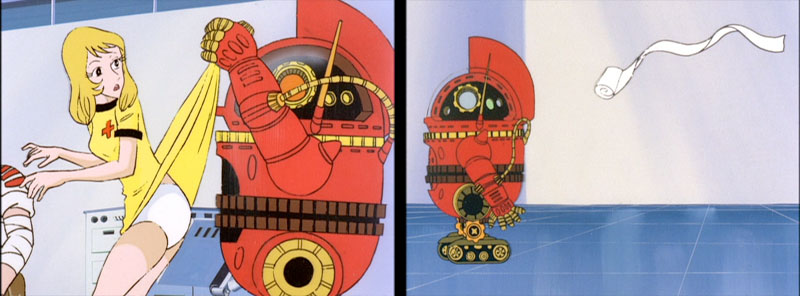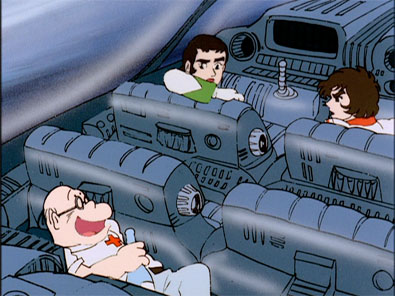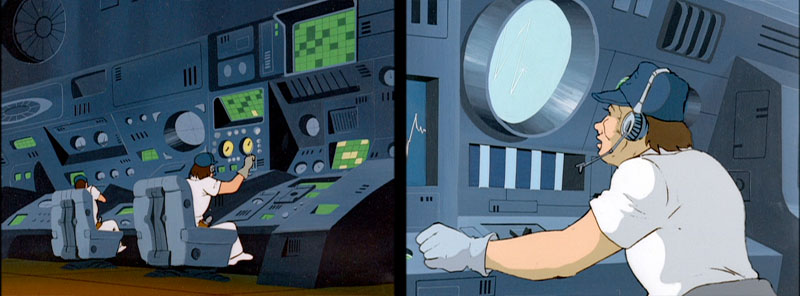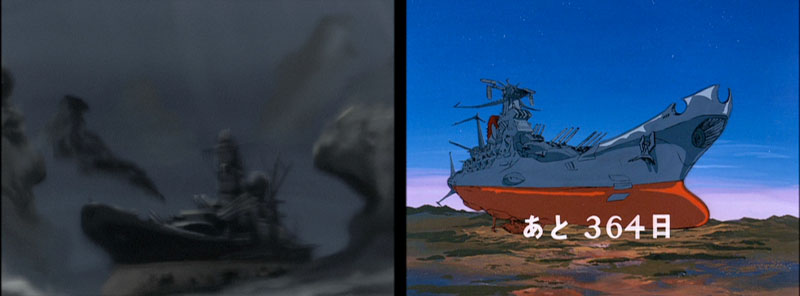The Opening Gun! Space Cruiser Argo Starts!
By Arthur Painter (with notes from Tim Eldred)
4 October 2199
Production note: This episode was originally saved in Japan by bad weather. On October 13, 1974, a major baseball game was scheduled to pre-empt the broadcast, but fortunately for Yamato it was rained out and delayed by a day.
Episode 2 originally had a 3-minute World War II flashback sequence depicting the sinking of the Imperial Japanese Navy Battleship Yamato. It was completely excised from Star Blazers and the lost time was filled by replaying the last few minutes of the previous episode, where Wildstar and Venture crash their recon ship and discover the Yamato ruins. This sequence ends with a shot of the ruined superstructure, while the narrator waxes poetic about the ship: “At one time, the Yamato was a great battleship. It fought nobly until the end. While rust and decay have taken away her once-sleek beauty, the legend remains bright, a legend of bravery and sacrifice. Now, just as the ancient ship appears again, the legend will come alive again. A legend and a ship that will save Earth!”
This little bit of background was not a true replacement for the WWII sequence, but was still helpful to young American viewers nonetheless. Unfortunately, this preamble (which opened with a beautiful scene of the sun rising over the burnt Earth) is not found in the Voyager DVDs, most likely due to the repetition of material which would be especially noticeable if the episodes were watched back-to-back.

This episode begins with Captain Avatar walking through EDF HQ where he overhears grim reports from all over the world, places with names like “Pan Am”, “the Afro States”, Asia Minor, “Anglia,” “Euroland,” and the Ukraine (which seems to be the only 21st Century country that kept its name to the end of the 22nd century). All of these places are fading fast. Avatar now seems more determined than ever to reach Iscandar. Something must have happened to him between episodes, since his arm is now in a sling–except for a couple scenes where it isn’t.
If you’re wondering, Space Battleship Yamato used real name places: New York, Paris, Kenya, Moscow, Beijing, and Rio de Janeiro.
We then cut to a scene of Nova treating Wildstar and Venture for the wounds they suffered in the recon ship crash. She mentions rumors about the Yamato retrofit. IQ-9 enters the room, complaining that his work is menial labor, unfit for a “genius robot”.
Production note: According to the storyboard for this episode, Kodai was to be bandaged up by a different nurse before it was decided to give Yuki the job instead.
There are several differences between this scene and the way it was written in Yamato. For one thing, Yuki (Nova) does not mention the ship. Instead, she comments to Kodai (Wildstar) that it’s lucky he survived the crash. Another change is IQ-9’s dialogue. In Yamato, he had none. His Japanese counterpart, Analyzer, is completely silent as he wheels into the room and sets down his tray. Then, in a scene removed from Star Blazers, he proceeds to playfully lift Yuki’s skirt, much to her shock and dismay. Such “panty shots,” usually caused by Analyzer, were numerous in Yamato.
Additional note from Matt Murray: This infirmary scene is somewhat problematic from a timeline point of view, since it places the events of this episode shortly after those of the first. Wildstar and Venture leave the medical bay and within two minutes are inside a completely retrofitted Yamato, complete with Wave-Motion engine. Avatar and the EDF commander were only just viewing the engine plans for the first time when the alert came over the PA about the Gamilon recon plane, which prompted the flight in which Wildstar sustained the injury for which he’s now being treated. It seems as though less than a day has passed in the interim.

Wildstar and Venture are addressed on the loudspeaker and told to report to a waiting aircar. IQ-9 comes along as well. In the aircar, they discover Dr. Sane testing a bottle of his “motion sickness remedy” behind the back seat. Dr. Sane is almost always shown with a bottle of his favorite sake in his hands, which Star Blazers invariably either edits out or changes to something more innocuous, like soybean milk or spring water. In Star Blazers, Dr. Sane was evasive and pseudo-philosophical about his reasons for being in the car, while in Yamato, Dr. Sado (Sane) states that he was summoned, just as the two men were.

They arrive at an underground factory, with a spaceship hull embedded in the cavern roof above. They board an elevator and soon find themselves on the bridge of Yamato, the ruins of which they discovered the other day. While the exterior is just a “rusty hulk,” the interior is completely redesigned for its new use as a space battleship. Nova’s here too, out of her nurse’s uniform and into a yellow jumpsuit. Even with the change of clothes, she still managed to beat them to the bridge. Maybe they stopped somewhere along the way and sampled some of that “motion sickness remedy?”
As with the earlier scene with Nova, the Star Blazers script is much more revealing. It’s stated clearly, both in the underground factory and when they’re on the bridge, that the ship is the Yamato. In the original show, Kodai and Shima (Wildstar and Venture) don’t realize this until they talk to the Captain at the end.
Avatar tells Wildstar and Venture that he’s chosen them for the “Star Force,” a special group of the best and brightest from around the world (places like Euroland, Anglia, and Pan Am, no doubt). The name “Star Force” was invented by the Star Blazers writers to make the crew stand apart from the ship. In the future, whenever you hear the names “Star Force” or Argo, the Japanese script simply said Yamato. Interestingly, Star Force was going to be the English title for the series, but it was probably changed due to its aural similarity to Star Wars.
Before Avatar can finish his recruitment speech, the ship is rocked by an explosion, followed by a report that there’s a high speed carrier heading right for them.

Production note: the wavy video screen images were the result of a common animation technique in which a warped sheet of glass known as a “ripple glass” was dragged, frame by frame, across the artwork to give the image a distorted effect. It was used to varying degrees of success in the early episodes, then later eliminated in favor of less camera work. Either that, or the ship’s video screens all got an upgrade. Look closely in this episode, and you can see a “simulated” ripple effect in a couple of scenes where animators simply drew wavy outlines on the Gamilon carrier.
The carrier unleashes its bombers and they begin to pummel the area around Yamato with missiles. There’s nothing the crew (all engineers at this point) can do. The bombers finish their run and move on to other targets. Advised by Leader Desslok that they’re “not being aggressive enough,” the carrier itself moves in for the kill.
I always wondered why the Gamilon commander’s movements are so shaky and jittery. Too much “space java,” maybe? Or is he nervous because he’s reporting directly to Leader Desslok?
Back on Yamato, they get some of the bridge systems working. Moments later, a low, steady hum is heard, and the engineers report that they finally have the auxiliary engines going. Avatar starts barking out commands as the ship comes to life. With Venture at the helm and Wildstar at the combat station, the ship breaks out of its rusty shell. The titular Space Battleship Yamato is revealed.

Production note: A different crew is shown operating the ship in its initial takeoff at the end of episode 2 whom we never see again. One explanation has emerged to account for their non-appearance afterward: that they spent so much time working on the ship they received an overdose of radiation and had to retire from further duty.
All three heavy shock cannons are locked on target and score a direct hit on the carrier. The carrier commander has time to contact Desslok and tell him that their target wasn’t an underground city, but a space battleship. The carrier commander’s death is up close and personal in the Yamato version. We see him fall to the floor as the explosion claims him.
Meanwhile, out in deep, dark space, Desslok learns that Earth now possesses a “huge space battleship.” He addresses three of his “brightest generals,” none of whom are identifiable in the scene and none of whom will actually appear again. Desslok turns to the camera and gets introduced by a caption, edited out of Star Blazers. I should probably note that these Gamilons, who are probably more familiar to casual fans as blue-skinned, appear with human skin tones. It wasn’t decided to make them blue until 10 episodes in.

Avatar tells his two recruits that the Yamato was “created in a time when great fleets sailed the seas, and there were wars among the nations of Earth.” It was at this point that Space Battleship Yamato showed a beautifully-animated scene of the sinking of the IJN battleship Yamato on April 7th, 1945. It’s easy to see why it was deleted from Star Blazers, as it would have been considered too intense for “children’s programming” in 1979. Not to mention the fact that, even though an American pilot is shown respectfully saluting the ship as it goes down, the Americans are the “bad guys” in this scene. This segment is available as a bonus feature on Volume 2 of the Quest For Iscandar DVD series. The version there is lifted from the Space Battleship Yamato movie, which differs slightly from the TV series.
Production notes: Though the World War II flashback sequence was completely cut from Star Blazers, it provided the first watershed moment among the staff of Space Battleship Yamato because of the use of a military marching anthem in the soundtrack. Leiji Matsumoto thought it would send the wrong message and insisted it be removed. Nishizaki relented after a lot of arguing, but a print of the episode had already gone out to Niigata Prefecture. There was still just enough time to change the music for all other cities, and the original track was only heard again on home video in later years. Read director Noboru Ishiguro’s account of this incident here.
Animation for this episode was by a studio named Tiger Pro, lead by Takeshi Shirato, who would participate in every Yamato production all the way to the end. He was also the director of The New Voyage. The World War II flashback was the handiwork of Kazunori Tomonaga, who would later become Yamato‘s general art director. He is said to have been inspired by the live action film Battle of Britain. The animation style strongly followed that of a unique 1971 TV anime series titled Animentary Decision, a retelling of Pacific theatre events in World War II. (It’s highly probable that some of Yamato‘s animators also worked on that series.)
Long after Yamato wrapped production, deep sea research vehicles investigated the wreckage of the original ship. It was determined that the hull had broken into two large fragments and many small ones, scattered on the ocean floor rather than resting in one piece as shown in the still below left. There is occasionally talk in Japan of raising what is left of the structure, but thus far it hasn’t gone any farther than that. Either way, if Space Battleship Yamato wasn’t a fantasy before, it certainly is now!

Avatar wraps up his recruitment speech by telling the pair “The Star Force needs you, and others like you.” Wildstar replies “I’m proud to go with you, sir, and to serve with the Star Force, as my brother would have been.” We see Avatar wince at that comment, which could be taken as a deliberate reminder that Wildstar holds him accountable for his brother’s death.
Okita’s (Avatar’s) dialogue in Yamato reveals something interesting here: he tells the two men that before the message from Iscandar, the space battleship was being rebuilt as an escape ship, a kind of Noah’s Ark, meant to take a selection of people and animals to find another world to live on.
Somehow, Yamato is able to rest on the Earth, seemingly sitting straight, with the third bridge and ventral hull fins clearly visible.
“There are 364 days left”

Interesting note: when the series first premiered, both in Japan and the US, the Ukraine was NOT an independent country, but part of the Soviet Union until 1991.
The below decks crew on this first battle were the engineers who built the Yamato. They were replaced by the official crew in the next episode. That’s why they are not seen again. I believe there’s some dialogue in Yamato ep 3 that presents this.